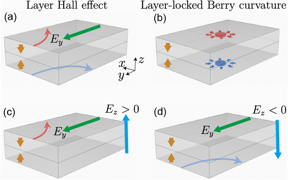Home > Press > Layer Hall effect and hidden Berry curvature in antiferromagnetic insulators
 |
| Schematics of the layer Hall effect (a) and layer-locked hidden Berry curvature (b) in a two-layer antiferromagnetic insulator. In the layer Hall effect, electrons are spontaneously deflected to opposite sides at different layers (the red and blue arrowed curves) due to the layer-locked hidden Berry curvature. (c)-(d) When a perpendicular electric field (the cyan arrow) is applied, the system shows layer-locked anomalous Hall effects tunable by the electric-field direction. The yellow arrows specify the antiferromagnetic configurations. The green arrows denote the in-plane electric field Ey for the Hall measurement.
CREDIT ©Science China Press |
Abstract:
This study is led by Prof. Hai-Zhou Lu and Prof. Qihang Liu (Shenzhen Institute for Quantum Science and Engineering and Department of Physics, Southern University of Science and Technology).
Layer Hall effect and hidden Berry curvature in antiferromagnetic insulators
Beijing, China | Posted on September 30th, 2022
Every time a new Hall effect is discovered, a wave of research will be inspired. The first experiment on a new type of Hall effect, the layer Hall effect, had been reported by Xus group at Harvard University. In the layer Hall effect, electrons from the top and bottom layers are deflected to opposite directions and was measured by applying an out-of-plane electric field to break the PT symmetry [see Figures (c) and (d) below], where P and T represent inversion symmetry and time-reversal symmetry, respectively. The authors proposed a universal picture in terms of hidden Berry curvature for the layer Hall effect [Figure (b)]. They show that the existence of the layer Hall effect is irrelevant to the electric field [Figure (a)], which is similar to the valley/spin Hall effect. Therefore, they also proposed an alternative approach, i.e., the nonlocal measurement, to identify the layer Hall effect, without applying the electric field.
On the other hand, the authors revealed three distinct features to enhance the layer Hall effect in PT-symmetric antiferromagnetic insulators. Moreover, the authors proposed more material candidates for the layer Hall effect, which will inspire more experimental explorations. Also, the hidden physics can be generalized to many degrees of freedom, including spin, orbital, and circular polarizations in the future.
####
For more information, please click here
Contacts:
Media Contact
Bei Yan
Science China Press
Expert Contact
Hai-Zhou Lu
Shenzhen Institute for Quantum Science and Engineering and Department of Physics, Southern University of Science and Technology (SUSTech)
Copyright © Science China Press
If you have a comment, please Contact us.
Issuers of news releases, not 7th Wave, Inc. or Nanotechnology Now, are solely responsible for the accuracy of the content.
Physics
![]()
Bound by light: Glass nanoparticles show unexpected coupling when levitated with laser light August 26th, 2022
![]()
Master equation to boost quantum technologies: FQXi-funded analysis will help physicists exert exquisitely precise real-time feedback control over quantum systems August 26th, 2022
![]()
Flexing the power of a conductive polymer: A new material holds promise for the next generation of organic electronics June 24th, 2022
Possible Futures
![]()
Researchers unveil mystery inside Li- o2 batteries September 30th, 2022
![]()
Synthesis of air-stable room-temperature van der Waals magnetic thin flakes September 30th, 2022
Discoveries
![]()
Surface microstructures of lunar soil returned by Change-5 mission reveal an intermediate stage in space weathering process September 30th, 2022
![]()
Researchers unveil mystery inside Li- o2 batteries September 30th, 2022
![]()
Synthesis of air-stable room-temperature van der Waals magnetic thin flakes September 30th, 2022
Announcements
![]()
Researchers unveil mystery inside Li- o2 batteries September 30th, 2022
![]()
Synthesis of air-stable room-temperature van der Waals magnetic thin flakes September 30th, 2022
Interviews/Book Reviews/Essays/Reports/Podcasts/Journals/White papers/Posters
![]()
Conformal optical black hole for cavity September 30th, 2022
![]()
Ultrasmall VN/Co heterostructure with optimized N active sites anchored in N-doped graphitic nanocarbons for boosting hydrogen evolution September 30th, 2022










